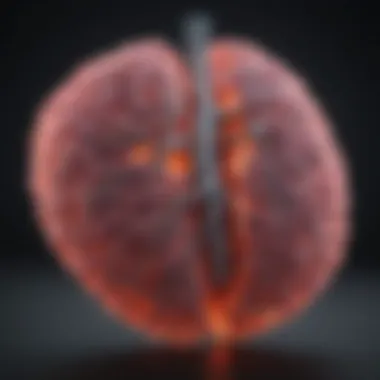Understanding ROS1 Fusion Lung Cancer: Key Insights


Intro
Lung cancer remains a leading cause of cancer-related deaths worldwide. Among its many subtypes, ROS1 fusion lung cancer is particularly noteworthy for its unique genetic profile. This condition is characterized by the fusion of the ROS1 gene with various partner genes, resulting in oncogenic properties that drive tumor growth. Despite representing a small percentage of lung cancer cases, understanding ROS1 fusions is crucial due to their distinct biological mechanisms and potential therapeutic targets.
The investigation of ROS1 fusion lung cancer encompasses a variety of aspects, from the molecular underpinnings leading to its formation, to the diagnostic techniques employed in identifying these fusions, and the treatment options available for affected patients. With ongoing research in this area, medical professionals and researchers alike are seeking to improve patient care and outcomes. This article aims to present a detailed exploration of these facets, emphasizing their relevance and implications for both clinical practice and future studies.
Methodologies
Description of Research Techniques
Research surrounding ROS1 fusion lung cancer employs multiple methodologies that contribute to a comprehensive understanding of this genetic alteration. Key techniques include next-generation sequencing (NGS), which allows for the detailed analysis of genetic material, and fluorescence in situ hybridization (FISH), which helps visualize the presence of ROS1 fusions within tumor samples. Liquid biopsies, capturing circulating tumor DNA, are also gaining attention as non-invasive approaches to detect such fusions.
Tools and Technologies Used
The tools and technologies involved in identifying ROS1 fusion events are varied. Some significant ones are:
- Next-Generation Sequencing: This powerful technique provides in-depth insights into the genomic landscape of lung cancer by identifying mutations and fusions.
- Fluorescence In Situ Hybridization (FISH): A critical method for detecting precise chromosomal rearrangements associated with ROS1.
- Real-Time Polymerase Chain Reaction (PCR): This technique is used to amplify specific genetic material, facilitating the identification of particular fusion genes.
- Liquid Biopsy Platforms: These innovative technologies analyze circulating tumor DNA and offer a less invasive alternative for monitoring ROS1 status over time.
Together, these methodologies and technologies enhance the accuracy and reliability of ROS1 fusion lung cancer detection, paving the way for tailored therapeutic strategies.
Discussion
Comparison with Previous Research
Research on ROS1 fusions has evolved significantly over the past decade. Earlier studies primarily focused on the identification of the fusion gene itself without much attention to its clinical implications. More recent investigations highlight the importance of understanding the prevalence and prognosis associated with ROS1 fusions, leading to targeted therapies such as crizotinib and entrectinib. These drugs have shown promise in improving patient outcomes compared to traditional chemotherapy.
Theoretical Implications
The exploration of ROS1 fusion lung cancer has substantial theoretical implications. Understanding the role of ROS1 in cell signaling and oncogenesis can inform broader cancer research efforts. The unique characteristics of ROS1 fusions can also provide insights into potential resistance mechanisms that might arise with treatment, underscoring the need for ongoing research and development of next-generation therapeutics.
The identification and understanding of ROS1 fusions in lung cancer represent not just a step in precision medicine but a transformative approach in how oncologists manage lung cancer at a molecular level.
Intro to ROS1 Fusion Lung Cancer
Understanding ROS1 fusion lung cancer is crucial for both medical professionals and those engaged in oncology research. This form of lung cancer is not just another subtype; it encapsulates a distinct genetic transformation that leads to unique clinical implications. Knowledge of ROS1 fusions allows for tailored therapeutic approaches and improved patient outcomes. Given the increasing incidence of lung cancer, it is imperative to explore this intricate subject deeply.
Definition and Overview
ROS1 fusion lung cancer arises from genetic alterations involving the ROS1 gene. These alterations typically result in the creation of hybrid genes through chromosomal rearrangements. This oncogenic fusion leads to the production of a unique protein that drives tumor growth. This specific mutation often manifests itself through non-small cell lung carcinoma, accounting for a lesser yet significant percentage of lung cancer cases. Patients diagnosed with ROS1 fusion lung cancer generally respond well to targeted therapy, especially with inhibitors like crizotinib, which points to the urgent need for precise diagnostic tests.
Historical Context
The recognition of ROS1 as a critical player in lung cancer began in the late 2000s. Initial studies linking the ROS1 gene to various forms of cancer laid the groundwork for understanding its role in lung carcinoma. The first report of ROS1 fusions emerged in 2007, quickly emphasizing the need for genomic analysis in lung cancer diagnostics. Over the years, extensive research has delineated the prevalence and biological importance of these fusions, leading to their incorporation into molecular profiling frameworks utilized in clinical practice today. This historical evolution underscores the significance of ongoing research into ROS1 fusion status as a determinant for treatment approaches and patient management strategies.
Molecular Biology of ROS1
The molecular biology of ROS1 is vital to understanding its role in lung cancer. The ROS1 gene, located on chromosome 6, encodes a receptor tyrosine kinase. This genetic alteration can lead to the formation of fusion proteins, which contribute significantly to cancer development. Studying the molecular aspects of ROS1 allows researchers and clinicians to identify specific mechanisms that facilitate tumor growth and progression.
The Role of ROS1 Gene


The ROS1 gene is pivotal in cell signaling pathways that control various cellular processes, including proliferation and differentiation. A fusion of the ROS1 gene with other genes disrupts these pathways, resulting in uncontrolled cell division. These fusions can promote oncogenic signaling, which ultimately drives the development of lung cancer. Understanding the function of the ROS1 gene helps elucidate the underlying biology of lung cancer, informing both diagnosis and treatment.
- Signal Transduction: The ROS1 protein plays a crucial role in transmitting signals from the cell surface to the interior. Disruption of its function alters numerous downstream pathways.
- Cell Proliferation: Elevated levels of ROS1 fusion protein can enhance cell proliferation, contributing to tumorigenesis.
- Clinical Implications: Identifying ROS1 fusions can significantly impact treatment decisions, as they are relevant for targeted therapies such as crizotinib.
Mechanisms of Fusion Events
The formation of ROS1 fusions generally occurs through chromosomal rearrangements. Several mechanisms have been identified that facilitate these events. Understanding these can help in predicting and diagnosing ROS1 fusion lung cancer more effectively.
- Translocations: This is one of the most common mechanisms leading to ROS1 fusions, where genetic material is exchanged between chromosomes, resulting in abnormal gene expression.
- Inversions: These occur when a segment of DNA breaks off, flips around, and reattaches, potentially creating a fusion gene.
- Duplication Events: Sometimes, parts of the ROS1 gene can duplicate, leading to increased activity and enhanced oncogenic properties.
It is essential to identify ROS1 fusions early, as they present unique targets for therapy that can improve patient outcomes.
Understanding these molecular mechanisms not only highlights the importance of ROS1 in lung cancer but also guides ongoing research aimed at developing innovative treatments that can improve survival rates for patients with ROS1 fusion lung cancer. Through detailed exploration of these dimensions, medical professionals can better navigate the complexities associated with this lethal disease.
Diagnosis of ROS1 Fusion Lung Cancer
Diagnosis is a critical step in managing ROS1 fusion lung cancer, as it influences treatment decisions and patient outcomes. Accurate diagnosis ensures that patients receive appropriate targeted therapies that can improve survival rates. Early identification of ROS1 fusions can lead to better treatment and increased chances of favorable outcomes. Hence, understanding the diagnostic methods for this particular cancer subset is essential for healthcare providers and patients alike.
Diagnostic Techniques
To diagnose ROS1 fusion lung cancer, various diagnostic techniques are employed. These methods include imaging studies, biopsy, and molecular testing.
- Imaging Studies: Initial assessment often begins with imaging, such as a computed tomography (CT) scan or positron emission tomography (PET) scan. These methods help identify suspicious nodules or masses in the lungs. However, imaging alone is not sufficient for confirming the presence of ROS1 fusions.
- Biopsy: A biopsy is usually necessary to collect tissue samples. This can be done through different approaches like bronchoscopy, where a thin tube with a camera is inserted to obtain tissue from the lungs. Needle biopsies can also be performed to extract samples from lung lesions.
- Molecular Testing: This is a pivotal step in the diagnosis. After obtaining the biopsy sample, advanced molecular techniques assess the presence of ROS1 fusions. Techniques include fluorescence in situ hybridization (FISH), reverse transcription-polymerase chain reaction (RT-PCR), and next-generation sequencing (NGS).
Each method contributes uniquely to ensuring that patients receive the correct diagnosis and, subsequently, the correct treatment.
Biomarkers and Genetic Testing
Biomarkers play a crucial role in the diagnosis of ROS1 fusion lung cancer. They can help identify patients who may benefit from targeted therapies. Genetic testing specifically looks for the presence of the ROS1 gene alteration.
- Biomarkers: The identification of proteins or gene alterations allows for the classification of tumors. Detecting ROS1 as a biomarker means that targeted therapies are viable options for the patient.
- Genetic Testing: Testing methods are expanding, with options like liquid biopsies gaining traction. Liquid biopsies analyze circulating tumor DNA from blood samples, providing a less invasive means to detect cancerous changes. These methods are proving to be promising in identifying ROS1 fusions.
- Implications: The presence of ROS1 can guide treatment recommendations. For instance, drugs like crizotinib target the ROS1 receptor, and their efficacy is high among patients with this genetic mutation.
Epidemiology and Prevalence
Understanding the epidemiology and prevalence of ROS1 fusion lung cancer is essential for medical professionals and researchers. This section sheds light on how widespread this specific type of lung cancer is and who is most affected by it. Knowing the epidemiological data can guide earlier detection, tailored treatments, and even public health strategies.
Statistical Data on Prevalence
Research indicates that ROS1 fusion lung cancer represents a minor but significant group within non-small cell lung cancer. It is estimated that about 1-2% of all lung cancers harbor ROS1 fusions. This may seem low, but with the overall incidence of lung cancer being high, this translates to a substantial number of patients. For instance:
- In the United States, approximately 228,000 new lung cancer cases are diagnosed each year.
- Thus, ROS1 fusions could affect around 2,280 to 4,560 new patients annually.
- Regions with high smoking prevalence may reveal a different profile of lung cancer, affecting the statistics related to ROS1 fusion cases.
"The rarity of ROS1 fusions may pose a challenge in clinical settings, emphasizing the need for genetic testing in lung cancer diagnoses to identify these cases."
The data also suggests that the prevalence of ROS1 fusion varies across different geographical locations and populations. Continuing to gather and analyze this data can lead to more insight into the factors contributing to ROS1 fusion cases.
Demographic Considerations
Demographic factors play a critical role in the prevalence of ROS1 fusion lung cancer. This includes age, gender, smoking history, and other socio-economic aspects. Research indicates:


- Age: ROS1 fusions tend to occur more frequently in younger patients, often in individuals under 50 years old.
- Gender: There is a noticeable difference in incidence between genders. Women are more likely to be diagnosed with ROS1 fusion lung cancer compared to men.
- Smoking History: Many patients with ROS1 fusions are light or non-smokers, which sets them apart from traditional lung cancer profiles primarily associated with heavy smoking.
Socio-economic status also influences access to healthcare and genetic testing, making it vital to consider these factors in epidemiological studies.
As research progresses, a focus on demographic shifts and changes in patterns of ROS1 fusion lung cancer incidence could impact future treatment protocols and patient management strategies.
Therapeutic Approaches
The topic of therapeutic approaches to ROS1 fusion lung cancer is essential in understanding how patients can effectively manage this subtype of lung carcinoma. With the identification of ROS1 fusions, several treatment strategies have emerged, which greatly influence patient outcomes. The therapeutic landscape focuses primarily on two categories: targeted therapies and traditional chemotherapy. Each approach has unique mechanisms, benefits, and considerations that warrant in-depth discussion to inform both patients and healthcare providers.
Targeted Therapies
Targeted therapies are based on specific genetic alterations in cancer cells. For ROS1 fusion lung cancer, these therapies aim to inhibit the signaling pathways activated by the ROS1 protein, which plays a critical role in tumor growth and survival. Drugs such as crizotinib and entrectinib have shown promising results. Clinical trials demonstrate that patients receiving targeted therapies often have improvements in progression-free survival rates compared to those on standard chemotherapy.
- Advantages of Targeted Therapies:
- Increased efficacy due to specificity to cancer cells.
- Typically result in fewer side effects compared to traditional agents.
- Offer patients hope through emerging combination therapies aimed at resistance options.
However, resistance to targeted therapies can develop. Therefore, monitoring and adapting treatment plans accordingly become crucial.
Chemotherapy Options
Chemotherapy has traditionally been the backbone of cancer treatment. In ROS1 fusion lung cancer, it remains a viable option, especially in cases where targeted therapy is not available or in patients with progressed disease. Common chemotherapeutic agents include carboplatin and pemetrexed.
While chemotherapy can effectively reduce tumor size and symptoms, it often comes with a range of side effects. Understanding these potential complications is critical for patient care:
- Common Side Effects:
- Nausea and vomiting.
- Fatigue and weakness.
- Risk of infection due to neutropenia.
Chemotherapy is usually not the primary choice for patients with ROS1 fusion lung cancer, but it may serve as a useful option to manage disease progression.
Clinical Trials and Emerging Strategies
The landscape of ROS1 fusion lung cancer is rapidly evolving. Current clinical trials are critical for identifying new treatment strategies and combinations of therapies. Emerging drugs and approaches show potential to improve the prognosis and quality of life for patients.
"Ongoing research continues to focus on combination therapies and novel agents as potential solutions to overcome resistance and to tailor treatments to individual patients."
- Noteworthy areas of research:
- Novel combinations of targeted therapies.
- Immunotherapies that could complement existing treatments.
- Investigational agents targeting specific ROS1 fusion variants.
The importance of patient enrollment in clinical trials cannot be overstated. It enables access to cutting-edge treatments and contributes to the overall understanding of ROS1 fusion lung cancer management. Patients and healthcare professionals should consider available options and weigh the benefits against potential risks when discussing treatment pathways.
Prognosis and Patient Outcomes
Understanding the prognosis and patient outcomes of ROS1 fusion lung cancer is crucial. These insights can significantly impact treatment decisions and the overall mental well-being of patients and their families. Prognosis refers to the likely course and outcome of the disease, providing patients with expectations regarding survival and quality of life. Having this information enables tailored therapeutic approaches and helps guide clinical trials and ongoing research in this specific area.
Survival Rates


Survival rates of patients with ROS1 fusion lung cancer differ from those with other types of lung cancer. Research indicates that patients with ROS1 fusions often have a better response to targeted therapies, which can enhance their overall survival rates. Studies have shown that, on average, the overall survival for patients with ROS1 fusion positive lung cancer may range from 20 to 30 months post-diagnosis. However, these statistics are general and could vary based on individual health factors, treatment response, and the stage of cancer at diagnosis.
Key factors influencing survival rates include:
- Age: Younger patients generally show better survival outcomes.
- Performance Status: Patients who maintain a higher performance status tend to cope better.
- Treatment Regimen: Effective use of targeted therapies, such as crizotinib, has been linked to improved survival.
Comparing this with standard lung adenocarcinoma patients reveals a notable difference in treatment outcomes, emphasizing the importance of early detection and mutation testing.
Factors Influencing Prognosis
Several factors can influence the prognosis for patients with ROS1 fusion lung cancer. Each patient's case is unique, and these influencing factors can range widely. The most notable elements include:
- Genetic Factors: The specific characteristics of the ROS1 mutation play a role in treatment effectiveness. Different fusion partners could lead to altered responses.
- Tumor Characteristics: The size, stage, and histological features of the tumor can provide insight into progression and treatment choices.
- Response to Treatment: Monitoring how well a patient responds to initial therapies is vital. Some patients may develop resistance to treatments, which can affect long-term outcomes.
- Comorbid Conditions: Other existing health issues can hinder treatment plans and affect overall prognosis. Treatments will need to be adjusted based on the patient's comprehensive health status.
"The prognosis of ROS1 fusion lung cancer, while generally more favorable than other lung cancer types, is multifaceted and demands personalized approaches to each patient's situation."
Research and Future Directions
Research into ROS1 fusion lung cancer is crucial for enhancing patient outcomes and improving therapeutic strategies. By understanding the molecular and genetic underpinnings of this cancer type, researchers can tailor interventions that specifically target ROS1 fusions. This section highlights ongoing studies, novel treatment options, and the advancing methodologies that promise to shape the future landscape of ROS1 fusion lung cancer management.
Current Research Developments
Recent studies emphasize several key areas in the development of targeted therapies for ROS1 fusion lung cancer. One significant focus is the optimization of existing drugs that inhibit ROS1 activity. Drugs like crizotinib and entrectinib show promise, but ongoing research seeks to refine them for better efficacy and reduced resistance.
Additionally, clinical trials are investigating combinations of targeted therapies with immunotherapy, aiming to enhance treatment response rates. Researchers are also exploring the biology of ROS1 fusions to develop biomarkers that could predict treatment outcomes. This is essential for personalizing therapy based on individual genetic profiles.
"Understanding the specific ROS1 fusion variant present in a patient may guide better treatment selection and improve survival rates."
Furthermore, new technologies, such as next-generation sequencing, are enabling the identification of novel ROS1 fusions that were previously undetectable. This advancement will likely lead to the discovery of diverse treatment strategies that reflect these newly identified molecular targets.
Potential New Treatment Modalities
The future of treating ROS1 fusion lung cancer may include several innovative strategies beyond the current therapy landscape. One potential modality is the development of
- Novel tyrosine kinase inhibitors (TKIs) designed specifically to target varied ROS1 fusion proteins.
- Combination therapies that integrate TKIs with other chemotherapy agents or immunotherapy are also being explored.
- Monoclonal antibodies that can precisely attack cancer cells harboring ROS1 fusions might enhance the therapeutic arsenal available.
- Advances in gene therapy could introduce options where corrective mechanisms are directly applied to the cancer cells.
In summary, underlining the significance of research and ongoing studies into ROS1 fusion lung cancer is not just critical, it is imperative for advancements in treatment effectiveness. With innovative research approaches, efforts are aimed at crafting strategies that will target the intricate biology of ROS1, ultimately leading to better healthcare solutions.
Ending and Implications for Patients
The discussion around ROS1 fusion lung cancer is not merely academic; it carries significant implications for patients diagnosed with this specific type of cancer. The nuanced understanding of ROS1 fusions assists clinicians in tailoring treatment strategies that can enhance patient outcomes. This section encapsulates the essential findings from the article while also addressing the implications for those affected by this condition, focusing on how advancements in research influence clinical practice and patient advocacy.
Summary of Key Findings
The central findings regarding ROS1 fusion lung cancer include:
- Genetic Basis: ROS1 gene fusions present a crucial pathophysiological mechanism underlying a subset of lung cancers. Understanding the genetic alterations helps guide targeted therapies.
- Diagnostic Techniques: Advanced methods such as next-generation sequencing and fluorescence in situ hybridization (FISH) are pivotal for detecting ROS1 fusions, facilitating early and accurate diagnosis.
- Treatment Options: Targeted therapies, such as crizotinib, have shown marked effectiveness in treating ROS1 fusion positive lung cancer, often leading to better patient responses compared to traditional chemotherapy.
- Prognosis: Patients with ROS1 fusion lung cancer generally demonstrate favorable outcomes with early detection and appropriate therapy, although prognosis can vary based on several factors like overall health and treatment adherence.
The findings emphasize the need for continuous research to further elucidate clinical outcomes and identify new therapeutic options.
Patient Education and Advocacy
Patient education is essential for those living with ROS1 fusion lung cancer. Understanding the disease, available treatments, and the importance of genetic testing can empower patients in their care. Here are several key elements of patient education and advocacy:
- Knowledge Empowerment: Patients should be informed about the nature of their illness, the role of the ROS1 gene, and potential treatment pathways. This knowledge can enable them to make informed decisions about their health.
- Communication with Healthcare Providers: Encourage open dialogue with oncologists and healthcare teams. Patients must feel comfortable discussing treatment options, side effects, and the overall management of their condition.
- Support Networks: Engaging with support groups and community resources can provide not only emotional support but also valuable information regarding personal experiences with ROS1 fusion lung cancer.
- Participation in Clinical Trials: Patients should be made aware of the opportunity to participate in clinical trials. These trials may offer access to cutting-edge therapies and contribute to the broader understanding of ROS1 fusion lung cancer.
- Advocacy for Research Funding: Advocacy efforts can help secure funding for continued research on ROS1 fusion lung cancer. Patients and their families can join forces to support initiatives that seek to advance treatments and improve outcomes.



